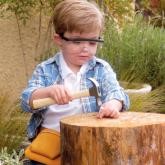The For Small Hands catalog is filled with hundreds of age-appropriate child-sized items that encourage independence, creativity, and problem-solving. This is a wonderful opportunity to purchase unique and educational holiday gifts and earn FREE materials for Our School. Look out for this catalog coming home.
Practical life in a Montessori classroom
The child in the toddler and primary class is introduced to lessons in Practical Life, which are unique to the Montessori early childhood environment. Practical Life activities are the activities of everyday life and include activities that teach the child how to take care of himself and his environment, develop social skills, independence and enhance fine muscle control. These activities are critical to a child’s development. They contribute to his control and coordination, concentration and self-confidence. These activities are cultural and relate to a child’s time and place. Beginning as early as eighteen months the child is offered real experiences to allow purposeful work and to allow him to become a member of the community who can take care of himself and provide service to the community.
“Through practical exercises of this sort the children develop a true ‘social feeling’, for they are working in the environment of the community in which they live, without concerning themselves as to whether it is for their own, or for the common good.”
The Discovery of the Child p 95, Chap 5
The activities are all based in reality. We wash dirty dishes with real soapy water, we clean mirrors with real polish and cut fruit with a real knife. These activities include but are not limited to food preparation, folding clothes, table scrubbing, hand washing, sewing buttons, sweeping the floor, pouring water, polishing wood, cleaning glass, watering the plants, washing dishes.
Each activity is attractively set upon a tray with child sized tools and containers in a particular place so that the children can go about their chosen activities independently. Each activity is prepared with everything the child will need for successful completion of the task.
It is important to notice… that these are real, not make-believe activities and that they are carried out in a real and not make-believe environment. The child who is washing dusters is washing real dusters because they are dirty; the children who are laying the table are laying a real table with real knives and forks and plates etc, for a real meal – not a doll’s table in a doll’s house for a doll’s tea party. Where you see a child swabbing up water spilt on the floor there has been a real accident, and she is reestablishing order to a real world. This is a matter of great importance…”
Maria Montessori: Her Life and Work p214, Chap XIII
Since there are several steps in learning some of the skills, they are presented to the child in a sequential manner, with the degree of difficulty increasing with each activity. In the pouring exercises the first step is an activity where the children pour beans or pasta from one glass pitcher to another. This aids the child with eye-hand coordination. And as each bean must be returned to the pitcher, the child uses his pencil grip to pick up the beans.
After practicing pouring with a range of dried foods the children are ready for pouring water. Again, eye-hand coordination is important, and any spilled water must be mopped with a sponge. From this children progress to pouring into different shaped vessels. Changing out the color of water, and the objects for pouring, attracts the child so that he repeats the exercise often.
As a child repeats the exercise he is gaining control over his unruly movements while developing fine motor control. The exercises assist in focusing attention, and approaching a task in a sequential manner. The activity also prepares the hand for writing.
The fine preparation necessary for the skill of handwriting is often ignored to the detriment of the child. Before the advent of laborsaving devices, children were required to participate in daily chores around the house and garden. These activities involved motor skills, which prepared their hand for the process of writing. Without this preparation, writing can be laborious for the child, and the product is difficult to read.
Practical life exercises help the child develop the muscles that control the pencil in the hand, as well as the wrist muscles that are necessary to move the hand across the page while writing.
Practical life exercises in the elementary classroom focus on care of self, care of the environment, cooperation and continued practice of grace and courtesy. Activities begin to extend outside the classroom through community service projects.

